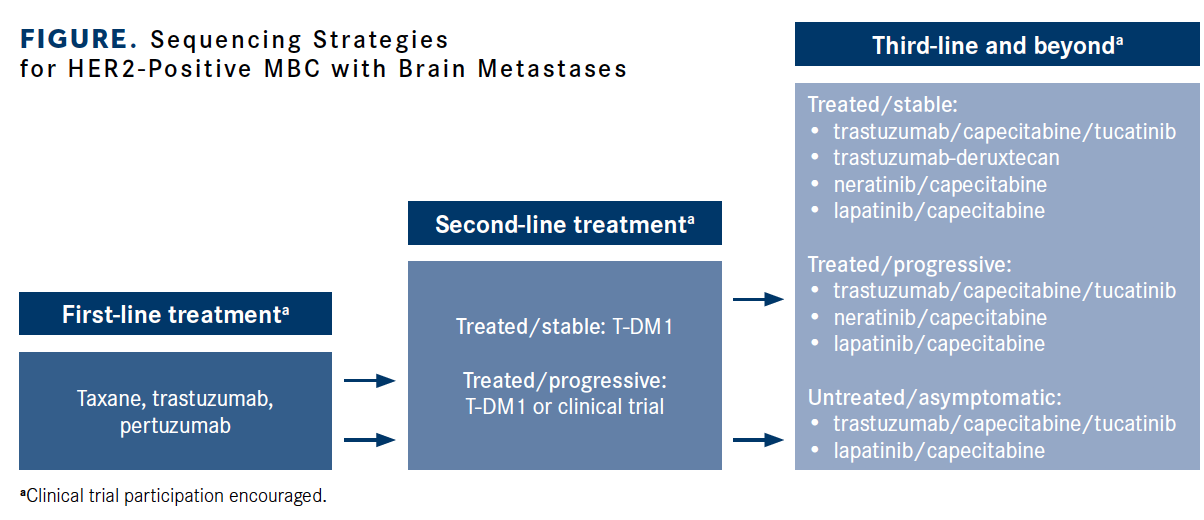Publication
Article
Oncology Live®
Sequencing Options Expand for Patients With HER2+ MBC and Brain Metastases
Collectively, there are more options than ever in the space of HER2-positive breast cancer brain metastases, a significant advance for our hundreds and thousands of patients facing this challenging disease.
Carey K. Anders, MD, director, Brain and Spine Metastasis Program, Duke Cancer Institute

Carey K. Anders, MD
Up to half of patients with HER2-positive metastatic breast cancer (MBC) treated with trastuzumab (Herceptin)-based therapy will develop breast cancer brain metastases (BCBMs).1 Women with early-stage HER2- positive breast cancer treated in the adjuvant setting with trastuzumab-based therapies and/or ado-trastuzumab emtansine (T-DM1; Kadcyla) are at risk of developing BCBMs, which are often the only site of recurrence.2
Isolated intracranial recurrence remains a clinical problem in the early stage and advanced setting and is likely due to poor central nervous system (CNS) penetrability of the best available HER2-targeted agents used in HER2-positive early-stage MBC (trastuzumab, pertuzumab [Perjeta], and T-DM1). First-line treatment of HER2-positive MBC includes taxane-based chemotherapy added to trastuzumab (T) and pertuzumab (P) for at least 6 cycles followed by TP alone (with the addition of endocrine therapy for patients with hormone receptor—positive disease).
Click to Enlarge

In the third-line setting and beyond, we have several options with clear evidence of intracranial efficacy in the treatment of HER2-positive BCBMs (Figure). Our arsenal of highly effective, targeted agents including tyrosine kinase inhibitors (TKIs) and antibody-drug conjugates for the treatment of HER2-positive MBC in the third line and beyond has expanded by more than 50% in the past year.
The combinations of neratinib (Nerlynx)/ capecitabine, tucatinib (Tukysa)/trastuzumab/ capecitabine, and fam-trastuzumab deruxtecan-nxki (Enhertu) have all shown impressive results in the past year for patients with HER2-positive BCBMs. Given these breakthroughs that have broadened the arsenal of treatment options for our patients, oncologists are now left with uncertainty about how to best sequence therapies for patients with HER2-positive BCBMs that will optimize both intracranial and extracranial progression-free survival (PFS), and OS, especially in the third-line setting and beyond. Choice of and sequencing of therapy between neratinib/ capecitabine; tucatinib/trastuzumab/capecitabine; and trastuzumab-deruxtecan generally depends on stable versus progressive nature of brain metastases, prior systemic treatments, state of extracranial disease status, and diverse toxicity profiles.
What to Do With First Intracranial Recurrence?
Initial treatment for BCBMs in patients with HER2-positive breast cancer traditionally includes local therapies, such as neurosurgical resection and/or radiation therapy (stereotactic radiosurgery vs whole brain radiation). Resection is considered with a single, space-occupying brain metastasis when systemic disease is otherwise stable in patients with a good performance status. Stereotactic radiosurgery is the preferred radiation modality for a limited number of brain metastases. Current national guidelines recommend local therapy to the existing brain metastases and to continue on current HER2-targeted systemic therapy if extracranial disease is stable or absent.5
For example, patients receiving first-line TP would receive upfront local therapy and then continue on TP if extracranial disease is stable or absent. Upon second and third intracranial recurrence, the treatment course is highly patient-specific, and there is no single consensus on local therapy or systemic treatment recommendations. Multidisciplinary evaluation is recommended.
Neratinib and Capecitabine
Neratinib is an oral, irreversible, TKI with activity against HER1, HER2, and HER4. Neratinib has shown intracranial efficacy and blood—brain barrier penetration in preclinical models.6 The Translational Breast Cancer Research Consortium 022 trial (TBCRC 22; NCT01494662) is a phase 2, open label clinical trial of neratinib 240 mg once daily plus capecitabine 750 mg/mg2 twice daily for 14 days on/7 days off.7 A strength of this study is that patients have to have measurable and progressive HER2-positive BCBMs after local therapy.
Forty-nine patients enrolled in cohorts 3A/ lapatinib-naÏve (n = 37) and 3B/prior lapatinib (Tykerb) (n = 12; cohort closed for slow accrual). The CNS ORR was 49% in cohort 3A (95% CI, 32%-66%) and 33% in cohort 3B (95% CI, 10%-65%). Median PFS was 5.5 and 3.1 months in cohorts 3A and 3B, respectively. Of note, single-agent neratinib was studied with minimal efficacy.
Click to Enlarge

The PFS was 8.8 months versus 6.6 months favoring N+C. Six- and 12-month PFS rates were 90.2% versus 87.5% and 72.5% versus 66.7% for N+C versus L+C, respectively (HR, 0.88; 95% CI, 0.72-1.07; P = .2086). OS was similar between arms. Clinical benefit rate (44.5% vs 35.6%; P = .0328) and duration of response (HR, 0.50; 95% CI 0.33-0.74; P = .0004) favored N+C. Time to intervention for symptomatic CNS disease (overall cumulative incidence 22.8% vs 29.2%; P = .043) was delayed with N+C versus L+C. Importantly, there was a higher rate of grade 3 diarrhea with N+C versus L+C (24.4% vs 12.5%). Based on results of the phase 2 CONTROL study (NCT02400476), rates of grade 3 diarrhea can be more effectively managed with prophylactic loperamide and the addition of colestipol to improve gastrointestinal toxicity.9 The FDA approved neratinib for HER2-postitive MBC on February 26, 2020, for patients who have received at least 2 lines of anti-HER2—based regimens in the metastatic setting.
Conclusion
The accumulation of data suggests that neratinib and capecitabine together have intracranial efficacy in both stable and progressive brain metastases in patients who have received at least 2 prior HER2-directed regimens. Intracranial response is superior in a lapatinib-naÏve population but is still respectable in a lapatinib-treated population. Diarrheal prophylaxis is paramount for tolerability of this combination.
Tucatinib
Tucatinib is an oral, potent, HER2-specific reversible TKI, demonstrating preclinical intracranial activity when used with standard doses of capecitabine and trastuzumab.10 In 2 phase 1b dose-escalation trials, tucatinib in combination with either trastuzumab/capecitabine, trastuzumab alone, or T-DM1 showed encouraging intracranial disease activity and control in patients with untreated, progressive, or stable HER2-positive metastases.11
Furthermore, practice-changing results were recently reported for the phase 2, randomized, multicenter, international, HER2CLIMB trial (NCT02614794) in patients with HER2-positive MBC that were treated with the addition of tucatinib to trastuzumab and capecitabine versus trastuzumab, capecitabine, and placebo. All patients in this trial had received previous TP and T-DM1; therefore, the regimen was beyond second line. Patients with stable untreated, treated progressive, and stable treated brain metastases were well-represented, a novel inclusion criterion for a phase 2 clinical trial in MBC.
The addition of tucatinib improved both PFS and OS in the intention-to-treat population and the population with BCBMs. For the patients with brain metastases (47% of participants), the addition of tucatinib resulted in a 52% reduction in disease progression or risk of death (HR, 0.48; 95% CI, 0.34-0.69; P <.00001).12 Among the 511 patients with measurable disease, the percentage who had a confirmed objective response was 40.6% (95% CI, 35.3%-46.0%) in the tucatinib-combination group and 22.8% (95% CI, 16.7%-29.8%) in the placebo-combination group (P <.001).
The FDA approved tucatinib in combination with trastuzumab and capecitabine on April 17, 2020, for the treatment of patients with HER2-positive MBC, including patients with brain metastases who have received 1 or more prior anti-HER2 based regimens in the metastatic setting.
Conclusion
Tucatinib in combination with trastuzumab and capecitabine is an excellent option for women with HER2-positive BCBM after progression of pertuzumab, trastuzumab, and T-DM1. Sequencing of tucatinib prior to or in combination with T-DM1 is an area of active research. Our preference would be to enroll patients in the ongoing, phase 3 clinical trial of T-DM1 with or without tucatinib that allows patients with brain metastases (NCT03975647).
Trastuzumab Deruxtecan
Trastuzumab deruxtecan is an antibodydrug conjugate including an anti-HER2 monoclonal antibody, a cleavable tetrapeptide-based linker, and a healthy payload of cytotoxic topoisomerase I inhibitor. It has a higher drug-to-antibody ratio than T-DM1 (approximately 8 vs 3-4, respectively).
DESTINY-Breast01 (NCT03248492) was a 2-part, open-label, single-group, multicenter study of trastuzumab deruxtecan in adults with pathologically documented HER2- positive, unresectable MBC who had received previous treatment with T-DM1. In total, 184 heavily pretreated patients (median 6 previous treatments) received trastuzumab deruxtecan 5.4 mg/kg. In the intention-totreat analysis, a response to therapy was reported in 112 patients (60.9%; 95% CI, 53.4%-68.0%). The median response duration was 14.8 months (95% CI, 13.8-16.9), and the median duration of PFS was 16.4 months (95% CI, 12.7-not reached).
This is an unprecedented finding in such a heavily pretreated population. Patients on this study could have stable brain metastases; untreated or symptomatic brain metastases was an exclusion criterion. In total, 24 patients with stable brain metastases were included and, among those, the median PFS was 18.1 months (95% CI, 6.7-18.1). Intracranial efficacy was not tracked formally. Pneumonitis is a serious adverse event observed with trastuzumab deruxtecan.
Conclusion
Further studies are needed to understand intracranial efficacy of this compound and optimal usage in patients with untreated or progressive brain metastases despite prior local therapy. Trastuzumab deruxtecan is an excellent option for patients with stable/treated brain metastases and no history of pneumonitis.
The Bigger Picture
At the current time, the recommended first- and second-line treatment of patients with HER2-positive MBC and brain metastases remains the same as those without brain metastases: (1) taxane/ trastuzumab/pertuzumab (2) T-DM1. Pertuzumab added to trastuzumab and a taxane prolonged survival in patients who eventually went on to develop BCBM. T-DM1 improved overall survival in patients with baseline stable/treated brain metastases over capecitabine/lapatinib in the second-line setting in a subgroup analysis. Tucatinib added to trastuzumab and capecitabine was recently approved after 1 prior line of HER2-targeted therapy; however, all patients in the pivotal trial had received both prior TP and T-DM1.
Studies are ongoing and in the planning phases to determine the impact of moving tucatinib, in combination with HER2-targeted agents, earlier in the traditional treatment sequence, particularly for those with BCBM. We would encourage participation in these important clinical trials to gain evidencebased guidance.
Upon first intracranial progression, CNS-directed, local therapy is typically recommended for the majority of patients. Systemic therapy following local therapy has been shown to improve survival and is recommended pending the patient’s performance status.13 Treatment choice largely depends on the status of extracranial disease. If the patient is stable or if there is no evidence of disease, continuing current therapy at first intracranial progression is preferred. If extracranial disease is progressive, advancing to the next line of therapy is recommended. Upon further intracranial progressions, recommendations are patient-specific and tailored by prior CNS and systemic treatments, patient performance status, and adverse event profiles. It is increasingly appealing to introduce highly effective, CNS-penetrant drugs such as tucatinib into the earlier settings in patients whose intracranial disease is the primary disease site. A phase 3 clinical trial of tucatinib added to T-DM1 is ongoing and is enrolling patients with untreated, stable, or progressive brain metastases (NCT03975647).
We now have several good options beyond the second-line setting for patients with HER2- positive BCBM (Figure).
Factors paramount in determining which agent to select and when include both extracranial disease status and the status of intracranial disease—stable and treated, treated and progressive, or asymptomatic and untreated. For patients with stable brain metastases after local therapy who are progressing extracranially, tucatinib/trastuzumab/capecitabine or trastuzumab deruxtecan are both reasonable choices. For patients with rapid, visceral progression in need of a robust response, the overall response rate of trastuzumab (61%) is superior to HER2-directed TKIs, with corresponding duration of response approaching a year and half. Trastuzumab deruxtecan has yet to be formally studied in patients with treated, but progressive, or previously untreated brain metastases and intracranial response remains unknown.
Finally, tucatinib/trastuzumab/capecitabine and neratinib/capecitabine have both illustrated efficacy in treated, but progressive or untreated brain metastases; however, these regimens have not been compared head to head. It is important to note that activity of neratinib/ capecitabine after lapatinib is more limited.
Collectively, there are more options than ever in the space of HER2-positive BCBM, a significant advance for our hundreds and thousands of patients facing this challenging disease. Our goal now is to determine the optimal combination and sequence of therapies to extend survival in a meaningful way. Continued development of rationally designed clinical trials, and integrating systemic and local therapies, will lead the way forward.
References
- Gori S, Rimondini S, De Angelis V, et al. Central nervous system metastases in HER-2 positive metastatic breast cancer patients treated with trastuzumab: incidence, survival, and risk factors. Oncologist. 2007;12(7):766-773. doi:10.1634/theoncologist.12-7-766
- Exman P, Pernas S, Tolaney SM. How we treat locally advanced HER2-positive breast cancer. Clin Adv Hematol Oncol. 2019;17(5):271-280.
- Swain SM, Baselga J, Miles D, et al. Incidence of central nervous system metastases in patients with HER2-positive metastatic breast cancer treated with pertuzumab, trastuzumab, and docetaxel: results from the randomized phase III study CLEOPATRA. Ann Oncol. 2014;25(6):1116-1121. doi:10.1093/annonc/mdu133
- Krop IE, Lin NU, Blackwell K, et al. Trastuzumab emtansine (T-DM1) versus lapatinib plus capecitabine in patients with HER2-positive metastatic breast cancer and central nervous system metastases: a retrospective, exploratory analysis in EMILIA. Ann Oncol. 2015;26(1):113-119. doi:10.1093/annonc/mdu486
- Ramakrishna N, Temin S, Chandarlapaty S, et al. Recommendations on disease management for patients with advanced human epidermal growth factor receptor 2-positive breast cancer and brain metastases: ASCO clinical practice guideline update. J Clin Oncol. 2018;36(27):2804-2807. doi:10.1200/JCO.2018.79.2713
- Martin TA, Lalani AS, Avogadri Connors F, Bryce RP, Jiang WG. Preclinical characterization of neratinib in a blood-brain barrier co-culture model: therapeutic implications for breast cancers with brain metastases. Cancer Res. 2018;78(suppl 4; abstr P1-17-07). doi:10.1158/1538-7445.SABCS17-P1-17-07
- Freedman RA, Gelman RS, Anders CK, et al; Translational Breast Cancer Research Consortium. TBCRC 022: a phase II trial of neratinib and capecitabine for patients with human epidermal growth factor receptor 2—positive breast cancer and brain metastases. J Clin Oncol. 2019;37(13):1081-1089. doi:10.1200/JCO.18.01511
- Saura C, Oliveira M, Feng Y-H, et al. Neratinib + capecitabine versus lapatinib + capecitabine in patients with HER2-POSITIVE metastatic breast cancer previously treated with ≥ 2 HER2-directed regimens: Findings from the multinational, randomized, phase III NALA trial. J Clin Oncol. 2019;37(suppl 15; abstr 1002). doi:10.1200/JCO.2019.37.15_suppl.1002
- Barcenas CH, Hurvitz SA, Di Palma JA, et al. Effect of prophylaxis on neratinib-associated diarrhea and tolerability in patients with HER2-postitive early-stage breast cancer: phase II CONTROL trial. J Clin Oncol. 2019;37(suppl 15; abstr 548). doi:10.1200/JCO.2019.37.15_suppl.548
- Dinkel V, Anderson D, Winski S, Winkler J, Koch K, Lee PA. ARRY-380, a potent, small molecule inhibitor of ErbB2, increases survival in intracranial ErbB2+ xenograft models in mice. Cancer Res. 2012;72(suppl 8; abstr 852). doi:10.1158/1538-7445.AM2012-852
- Murthy RK, Hamilton EP, Farrario C, et al. Clinical benefit of tucatinib after isolated brain progression: a retrospective pooled analysis of tucatinib phase 1b studies in HER2-POSITIVE breast cancer. J Clin Oncol. 2018;36(suppl 15; abstr 1015). doi:10.1200/JCO.2018.36.15_suppl.1015
- Murthy RK, Loi S, Okines A, et al. Tucatinib, trastuzumab, and capecitabine for HER2-positive metastatic breast cancer. N Engl J Med. 2020;382(7):597-609. doi:10.1056/NEJMoa1914609
- Mounsey LA, Deal AM, Keith KC, et al. Changing natural history of HER2-positive breast cancer metastatic to the brain in the era of new targeted therapies. Clin Breast Cancer. 2018;18(1):29-37. doi:10.1016/j.clbc.2017.07.017
NALA (NCT01808573) was a phase 3 international, randomized clinical trial of neratinib plus capecitabine (N+C) versus the reversible dual TKI lapatinib plus capecitabine (L+C) in patients with HER2-positive MBC who had received at least 2 prior HER2-directed regimens.8 Six hundred twenty-one patients were randomized in a 1:1 fashion.
The addition of pertuzumab to taxane/ trastuzumab has increased time to BCBM development in the first line and has improved overall survival (OS) in patients who progress and develop BCBMs. This was demonstrated in the phase 3 CLEOPATRA trial (NCT00567190), which tested the regimen in MBC.3 Patients with baseline BCBMs were not included in the study population. T-DM1 is the current standard- of-care second-line treatment for patients with HER2-positive MBC due to its superiority over capecitabine/lapatinib demonstrated in the EMILIA clinical trial (NCT00829166). Patients with stable and treated baseline brain metastases were included in this clinical trial. Among patients with BCBM at baseline, there was a significant improvement in OS observed in the T-DM1 arm compared with the capecitabine/lapatinib arm (HR, 0.38; P = .008; median, 26.8 vs 12.9 months).4 At this time, for most patients, first- and second-line treatments for HER2-positive MBC are the same regardless of the presence or absence of brain metastases.





%20u.jpg?fit=crop&auto=format)

